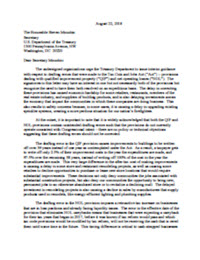Last month the Environmental Protection Agency (EPA) announced the first updates to its ENERGY STAR scoring models in over a decade, as the agency moved from 2003 to 2012 data for its foundation to rate buildings. (See Roundtable Weekly, Aug. 17.) EPA announced yesterday that it will commence a “review period” to solicit stakeholder feedback on these recent ENERGY STAR score updates. Certifications for office, industrial, and certain other building categories will be temporarily suspended during this review period.
 |
|
EPA announced yesterday that it will commence a “review period” to solicit stakeholder feedback on recent ENERGY STAR score updates. Certifications for office, industrial, and certain other building categories will be temporarily suspended during this review period. |
- ENERGY STAR is the key federal label that rates and compares U.S. buildings’ energy performance. Currently, EPA lists 34,625 buildings and plants, representing more than 5 billion square feet of commercial space across the country, as ENERGY STAR certified. Through initial analyses of Sustainability Policy Advisory Committee (SPAC) membership, The Roundtable learned that the application of the new 2012 data appears to result in materially different outcomes on scores depending upon building size, geography, and source of heating, and these outcomes were inconsistent. RER on behalf of the industry highlighted the issues to the EPA, and the EPA responded with the announced review period.
- “The review period will help us ensure that the models are working as intended to deliver energy performance metrics that empower … the business case for owning and operating energy-efficient buildings,” the agency stated. During the review period, EPA and real estate stakeholders will have the opportunity to assess variables such as a building’s size, location, and fuel mix, to fully consider if these and other factors have had an indiscriminate impact on the new scoring models.
- “We commend EPA in taking this step toward transparent decision making so our industry can recommend any necessary, data-driven changes to ENERGY STAR’s updated scoring models ,” said Roundtable President and CEO, Jeffrey D. DeBoer. “The Roundtable and our Sustainability Policy Advisory Committee look forward to partnering with EPA during its review period.”
- Other federal agencies, state and local governments, and non-governmental organizations frequently rely on ENERGY STAR’s tools and rating system for their own programs related to building energy efficiency. EPA advised it will “coordinate with program implementers and policymakers that leverage the ENERGY STAR score on the appropriate use of the new metrics during the review period.”
The review period and temporary suspension of ENERGY STAR building certifications do not apply to multifamily, data center, hospital, senior care communities, and manufacturing facilities, according to EPA.












